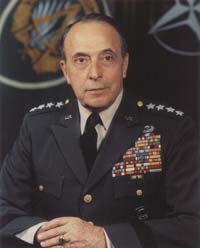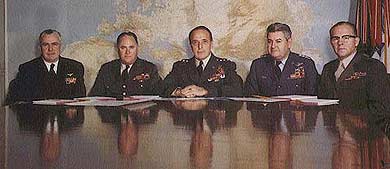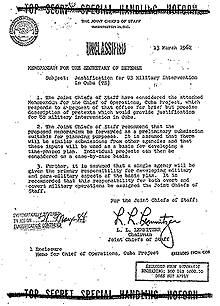The Terrorist Attacks Planned by the American Joint Chief of Staff against its Population | Operation Northwoods
 Attack the American military base in Guantanamo. The operation would be carried out by Cuban mercenaries wearing the uniform of Fidel Castro’s forces. Several sabotages would be made and the ammunition depot would be blow up. This would obviously provoke material damages and many deaths among the American troops.
Attack the American military base in Guantanamo. The operation would be carried out by Cuban mercenaries wearing the uniform of Fidel Castro’s forces. Several sabotages would be made and the ammunition depot would be blow up. This would obviously provoke material damages and many deaths among the American troops.
 To blow up a US warship in Cuban territorial waters to revive the destruction of the US Main in 1898 (266 dead) which caused the American intervention against Spain. [6].
To blow up a US warship in Cuban territorial waters to revive the destruction of the US Main in 1898 (266 dead) which caused the American intervention against Spain. [6].
 Terrorize the Cuban exiles living in the US by blowing up one of their facilities in Miami, Florida and even in Washington. Then, false Cuban agents would be arrested so that they could confess. Compromising false documents would be then confiscated and given to the press to prove Fidel Castro’s Cuban terrorists involvement in the attacks.
Terrorize the Cuban exiles living in the US by blowing up one of their facilities in Miami, Florida and even in Washington. Then, false Cuban agents would be arrested so that they could confess. Compromising false documents would be then confiscated and given to the press to prove Fidel Castro’s Cuban terrorists involvement in the attacks.
 To mobilize bordering countries to Cuba so that they could prove an invasion threat. A false Cuban plane would bomb the Dominican Republic or any other state of the region at night time. For obvious reasons, the bombs to be used were going to be Soviet.
To mobilize bordering countries to Cuba so that they could prove an invasion threat. A false Cuban plane would bomb the Dominican Republic or any other state of the region at night time. For obvious reasons, the bombs to be used were going to be Soviet.
 To mobilize the international public opinion. To achieve this, the destruction of a spaceflight was planned. With the purpose of really touching peoples’ feelings, the chosen victim would bee the famous astronaut John Glenn, the first American to make a complete flight around the Earth orbit (the Mercury flight).
To mobilize the international public opinion. To achieve this, the destruction of a spaceflight was planned. With the purpose of really touching peoples’ feelings, the chosen victim would bee the famous astronaut John Glenn, the first American to make a complete flight around the Earth orbit (the Mercury flight).
 “It was possible to fabricate an incident that would convincingly prove that a Cuban fighter plane had attacked and shot down a civilian charter flight departing from the U.S. with destination to Jamaica, Guatemala, Panama or Venezuela”.
“It was possible to fabricate an incident that would convincingly prove that a Cuban fighter plane had attacked and shot down a civilian charter flight departing from the U.S. with destination to Jamaica, Guatemala, Panama or Venezuela”.
OPERATION NORTHWOODS
The Terrorist Attacks Planned by the American Joint Chief of Staff against its Population
Conceived by the the American Joint Chief of Staff in 1962, the "Northwoods" operation foresaw a series of attacks killing civilians and American military men to mobilize the public opinion against Fidel Castro. An attack against a warship and a hijacking had notably been planned. Among the conspirators were people in charge of the the United States’ army by that time . The realization of this mentally ill plan was prevented, at the last minute, by the president John F. Kennedy.
Operation Mongoose
In 1958 in Cuba, rebels led by revolutionaries Fidel and Raul Castro, Che Guevara and Camilo Cienfuegos overthrew Fulgencio Batista’s regimen. Batista left the island and sought refuge in the U.S. The new revolutionary government, which was not communist by then, put an end to systematic exploitation of the island carried out by a number of American multinational companies (Standard Oil, General Motors, ITT, General Electric, Sheraton, Hilton, United Fruit, East Indian Co) and the Bacardi family. Then, these companies which lost the opportunity of becoming millionaire convinced President Eisenhower of overthrowing the Cuban revolutionaries led by Castro.
On March 17, 1960, President Eisenhower approved a “Program of Covert Operations against Castro’s Regime”. Its purpose was to “replace Fidel Castro’s regime and impose another one more loyal to the real interest of the Cuban people and those of the United States through secret means that would not reveal an American military intervention”. [1].
On April 17, 1961, a unit of Cuban exiles and mercenaries, discretely led by the CIA, tried to disembark at the Bay of Pigs. It was a huge failure. President John F. Kennedy, recently elected to the White House, refused to issue the order so that the US Air Force would back the mercenaries.
1500 men were captured by Cuban authorities. Kennedy opposed this action and fired CIA director Allen Dulles, CIA vice-director Charles Cabell and Stay-Behind project director Richard Bissell. Kennedy’s military adviser, General Maxwell Taylor was orderd to carry out an internal investigation that turned out to be useless. Kennedy questioned the Joint Chief of Staff action for it validated an operation which was destined to fail. [2] It seemed the generals wanted to get the US involved in an overt war against Cuba.
But, despite opposing CIA methods and failures, President Kennedy did not change Washington’s hostility against Havana’s regimen. A “Special Task Force” was in charge of designing and directing the anti-Castro struggle.
This group was formed by his brother, Robert Kennedy (attorney general), his military adviser (General Maxwell Taylor), the National Security Adviser (Mc Gorge Bundy), the Secretary of State (Dean Rusk), assisted by an adviser (Alexis Johnson), the Secretary of Defense (Robert McNamara), assisted by an adviser (Roswell Gilpatric), the new CIA director (John McCone) and the Chief of Staff (General Lyman L. Lemnitzer).
This group designed a number of secret actions known by the secret code of Operation Mongoose.
In order to implement it, the operational coordination between the Department of State, the Department of Defense and the CIA was entrusted to General Edward Lansdale (Assistant Secretary of Defense in charge of Special Operations and therefore director of the National Security Agency). At the same time, an ad hoc unit (“Group W”) directed by William Harvey was formed within the CIA.
The Crisis within the Army

- Lyman L. Lemnitzer
On April 1961, the American Army suffered a serious crisis: major-general Edwin A. Walker, the man that started the racist clashes in Little Rock before being appointed Chief of the US Infantry in Germany, was fired by President Kennedy. [3]. Walker was accused of developing an extreme right wing proselytism within the army. He himself was a member of the John Birch Society and the Ku Klux Klan.
The Foreign Affairs Commission of the Senate developed an investigation on the ramification of the extreme right wing groups within the army. The hearing were presided by Senator Albert Gore (D-Tennessee), father of the future American vice-president. Senators suspected the Chief of Staff, General Lyman L. Lemnitzer, was involved in Walker’s extreme right wing movements.
Gore knew that Lemnitzer was a secret operation expert: in 1943 he had been in charge of the negotiations to cause a rift between Italy and the Third Reich of Adolf Hitler; and in 1944, along with Allan Dulles, he led the secret negotiations with the Nazis in Ascona, Switzerland, to prepare Germany’s capitulation (Operation Sunrise). [4].
He was also involved in the creation of the Allies «stay-behind» network by using and recruiting Nazi agents to fight the USRR and helped war criminals and people accused of crimes against humanity to escape to Latin America. However, Gore was not able to prove Lemnitzer’s involvement in such facts.
The recently published secret correspondence of General Lemnitzer showed that he, the Commander of the American Forces in Europe (General Lauris Norstad), and some other high-ranking officers were conspiring against Democrat President John F. Kennedy’s policy.
Extreme right-wing officers opposed Kennedy’s refusal to involve the American Army in a military intervention in Cuba. They blamed CIA civilians for the bad planning of the Bay of Pigs disembark and accused President Kennedy of being a coward for opposing the use of the US Air Force to support the Cuban counterrevolutionaries.
But to go on with their plans, these American military men invented a political excuse so that Kennedy would intervene in Cuba. This plan was called: Operation Northwood. Several specific studies were made by General William H. Craig with the purpose of putting forward this secret project, which was later presented by General Lemnitzer to the Special Task Force on March 13, 1962 (our document).
The meeting was held at the Pentagon, in the Secretary of Defense office, from 14:30 (2:30 pm) to 17:30 (5:30 pm).It did not have a happy end. Robert McNamara rejected the whole plan and General Lemnitzer became more threatening. This provoked a six-months-permanent-hostility between Kennedy’s Administration and the Joint Chief of Staff, and Lemnitzer was sent to Europe as the Chief of the American forces there. Nevertheless, before leaving, the general ordered all secret documents of Operation Northwood to be destroyed but Robert McNamara, Kennedy’s Secretary of Defense by that time, kept a copy of the secret project. [5].

- The members of the Joint Chief of Staff involved in Operation Northwood
- From left to right: Almirant George W. Anderson Jr. (Chief of Navy Operations), General George H. Decker (Chief of the Land Forces section), General Leyyman L. Leymnintzer (Chief of the Joint Chief of Staff), General Curtis E. LeMay (Chief of the Air Force section), General David M. Shoup (Commander of the Marines)
Terrorists Attacks
Operation Northwood was aimed at convincing the international public opinion that Fidel Castro was an irresponsible man who was a threat to the world and the western peace. Thus, Operation Northwood’s designers planned to launch terrorist attacks in the US and against its interests to then blame Cuba for the damages suffered. Some of the actions planned were the following:
Actually, the ship would be empty and tele-guided and its explosion would have been seen from Havana or Santiago de Cuba so that potential eye-witnesses could say what happened. A rescue operation would then be organized to make it even more real; the passengers list would be published and false funerals would be organized to outrage the American and world public opinion. The whole operation would be carried out when Cuban planes and ships were in the area so that they could be blamed for the attack.
If all these was not enough to mobilize the international public opinion in support of a military invasion against Cuba, a last provocation was added to the list:
A group of conspiratorial passengers who could be students, for example, would be on board of this ghost-company’s charter flight under the control of the CIA. Once they were flying over Florida, an empty and without-a-pilot identical plane would follow the route. The conspiratorial passengers would then be taken to a CIA secret base. The plane would ask for help by saying it had been attacked by a Cuban fighter plane. Then, the plane would blow up.
The implementation of the said actions would actually cost the lives of many American citizens, civilians and military men, which was actually the key element for their manipulative functions.
Layman L. Lemnitzer: his Return
For John F. Kennedy, Lemnitzer was a hysterical and extremist anti-communist backed up by unscrupulous multinational companies. It was then that President Kennedy understood the real meaning of his antecessor, President Eisenhower, warning when the year before, in his farewell address he said: «The responsible of the government must be aware of an illegitimate influence whether it comes or not from the military-industrial complex. The risk of developing or using a usurped power exists and will remain present. We must not allow this threat to prevent us from our liberties and democratic processes. Nothing must be considered completely achieved. Only the proper surveillance and awareness can guarantee the balance between the lobby of the huge industrial and military machinery we have developed and our pacific methods and objectives so that security and freedom can work together». [7].
John F. Kennedy opposed Generals Walker, Lemnitzer and his friends and refused to involve the US in an overt war against communism in Cuba, Laos, Viet Nam or any other country. John Kennedy was murdered on November 22, 1963. [8].
General Lemnitzer retired in 1969 but in 1975, while the Senate was doing its investigation of the role played by the CIA during Nixon’s administration, Gerald Ford, who became president after the Watergate scandal, asked him to participate in the said investigation.
After this, Ford requested his services again to assist pressure group Committee on the Present Danger (CPD). This group was created by the CIA, which was then directed by George Bush senior. It campaigned against communism and promoted its threats. Among its leaders, there were several CIA officers and Paul D. Wolfowitz (current Assistant Secretary of Defense in charge of the operations in Afghanistan). At the same time, Gerald Ford promoted General William H. Craig to Major General. Craig had directed the preliminary analysis of Operation Northwoods as director of the National Security Agency (NSA).
General Layman L. Lemnitzer died on November 12, 1988.
In 1992, the American public opinion questioned President Kennedy’s murder after the transmission of filmmaker Oliver Stone’s film where inconsistencies on the official version were shown. President Clinton ordered archives on Kennedy’s presidency to be declassified and among them, Kennedy’s Secretary of Defense, Robert McNamara’s papers, secret project «Northwoods» was found.
[1] A Program of Covert Operations against the Castro Regime, a CIA April 16, 1961 declassified document
[2] The Chairmen of the Joint Chiefs of Staff, Willard J. Webb et Ronald H. Cole, DoD, 1989. Swords and Plowshares, Maxwell D. Taylor, 1972.
[3] See our research: «Les Forces spéciales clandestines», in Les Notes d’information du Réseau Voltaire n° 235. For more details, see Chris Cravens: Edwin A. Walker and the Right Wing in Dallas, South Texas State University, 1993
[4] Les Secrets d’une reddition, Allen Dulles, Calmann-Lévy, 1967
[5] Operation Northwood documents have been published in Australia by Jon Elliston (Psy War on Cuba, The Declassified History of US Anti-Castro Propaganda, Ocean Press Ed., 1999) without provoking reactions within the U.S. They have been also used by ABC News journalist James Bamford in his NSA story (Body of Secrets, Anatomy of the Ultra-Secret National Security Agency from the Cold War to the Dawn of a New Century, Doubleday Ed., 2001) which was welcomed by historians
[6] By then, Cuba was a Spanish colony. The United States intervene militarily to put an end to the colonization of Cuba and impose a protectorate
[7] Dwight Eisenhower, Farewell Address, January 17, 1961
[8] William Reymond: JFK, Autopsie d’un crime d’État, Flammarion, 1998




